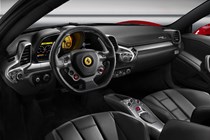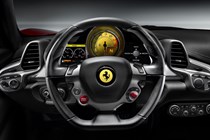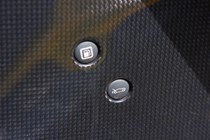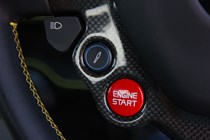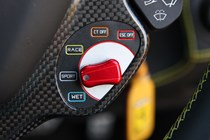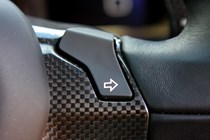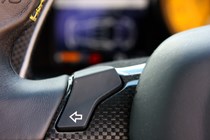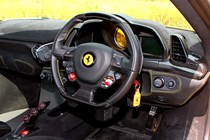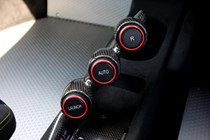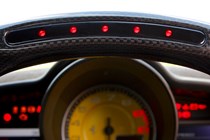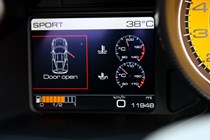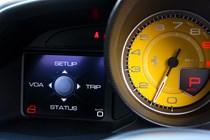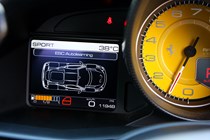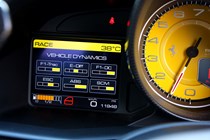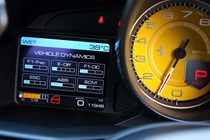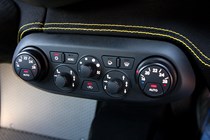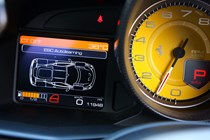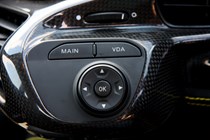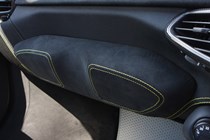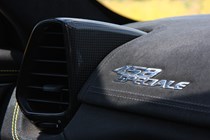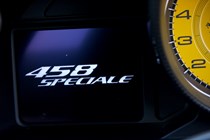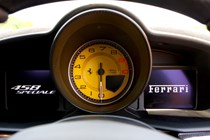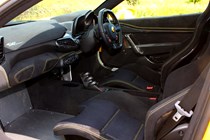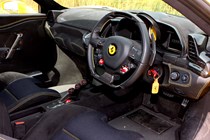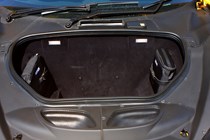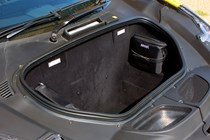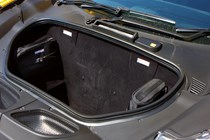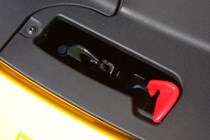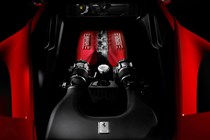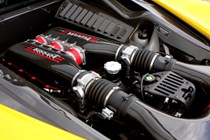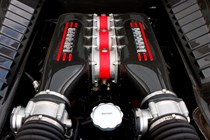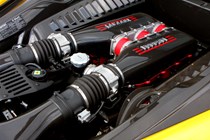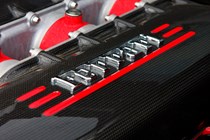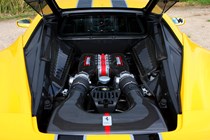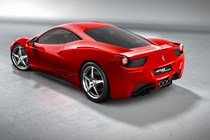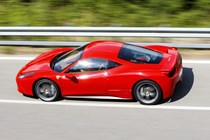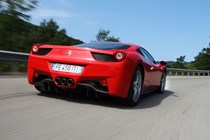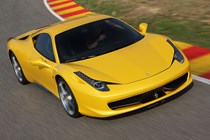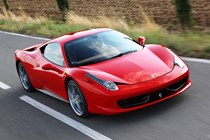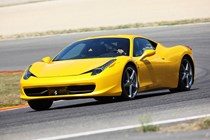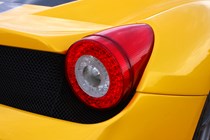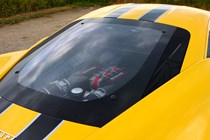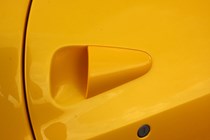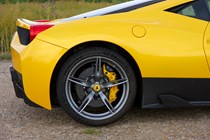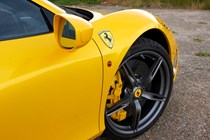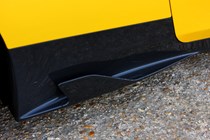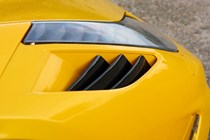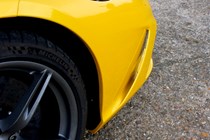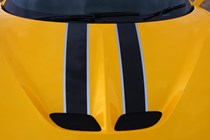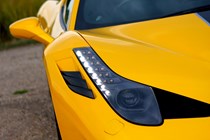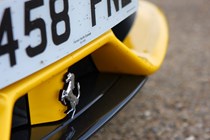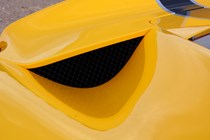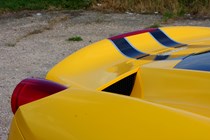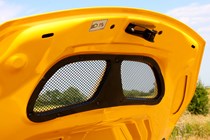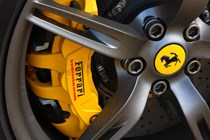
Ferrari 458 Coupe (2010-2016) interior, tech and comfort
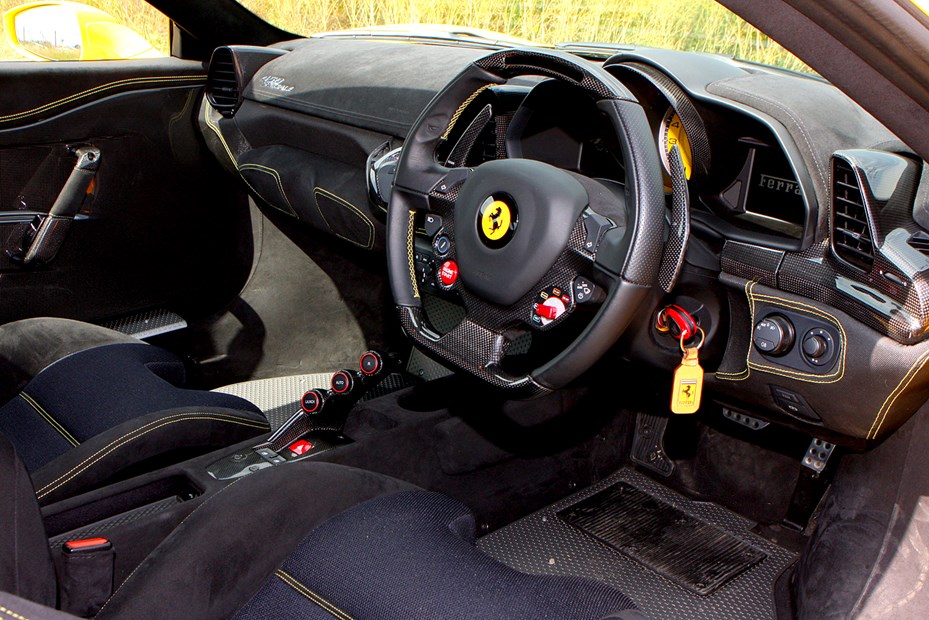
The inside is almost as dramatic as the outside, with a dashboard layout seemingly made up of a complex combination of flowing curves and forms. Certainly, even in its most basic form, the cabin of the Ferrari 458 Italia looks like it belongs to something special.
But for all its initial glitz and glamour, it’s actually fairly logically laid out. Dominating proceedings is that race-inspired steering wheel; featuring the engine starter, bumpy road suspension button and Manettino to select between driving modes. There’s five to choose from: Wet, Sport, Race, CT off and ESC off.
You’ll also spy the buttons for the windscreen wipers and washers, full beam headlight operation and indicators on there too. That’s to improve access to the large paddles for manual operation of the automatic gearbox, nestled neatly behind the steering wheel.
Initially it’ll take some getting used to, with hands wandering in the direction of an imaginary stalk, but within a few hours you’ll find it entirely natural. The ability to keep your hands on the wheel when driving at speed, still able to operate such ancillary controls, is an obvious benefit. You can even decide how you want to the indicators flash, with a quick press of the button turning them on normally and a slightly longer depression allowing for a three-flash operation.
The other dominating factor of the interior belongs to the oversized rev counter, sitting squarely in the middle of the instrument cluster – flanked by two multifunctional digital displays. Its numbers run to 10,000rpm, with a 9,000rpm redline, and it features a digital display within it to indicate your gear selection. That needle climbs incredibly quickly, but it’s easy to read, and if you choose the optional LED rev counter indicators within the top part of the steering wheel rim you’ll not likely need to pay much attention to it.
However, the digital speedometer shown in the right hand screen is important, and unless you’re using the sat-nav or adjusting the audio controls (also shown on this screen) we’d suggest leaving it on the speedometer to keep an eye on your speed. The left-hand screen is much more multi-configurable, with information on fuel, water and oil temperature, oil pressure and trip information. It also houses the Vehicle Dynamics monitor, which highlights tyre, brake and engine temperatures plus what modes you have selected from the Manettino on the steering wheel.
Sat-nav is optional on both the 458 Italia and 458 Speciale, but the latter does without a stereo too – at which point the right hand screen only operates as a digital speedometer. Some of the other switchgear, especially the climate control, light switch and electric mirror adjustment looks a little ordinary, and the latter pair can be a bit of a stretch for some drivers, but everything works effectively.
Getting comfortable is easy thanks to plenty of adjustment in seats and wheel, though the race seats in the Speciale don’t offer the same options as in the 458 Italia. Regardless, it was still easy enough to find ourselves sitting comfortably.
It’ll be up to you whether you are entirely impressed with the materials of the Speciale model – we don’t see anyone feeling short-changed in the leather-clad 458 Italia. Carbon fibre abounds, which is beautifully finished, and set against Alcantara and for the inner panels of the seats a breathable mesh-type 3D fabric. It feels rather utilitarian, which is in-keeping with the car’s intended purpose, we just aren’t wholly convinced by the textured metal plates with exposed screw heads used on the sills and inner floor areas – it looks a little too like typically aftermarket chequerplate to us.
Still, it’s a Ferrari, and none are sold ‘standard’ so it’s likely you’ll be able to order it with your ultimate choice of materials and not have to put up with someone else’s ideas of interior design, trim and taste.
You might actually be surprised by Ferrari 458 Comfort, even if you select the hardcore 458 Speciale model.
Despite the raucous exhaust noise, especially in the Speciale, intimidating power figures and substantial size you’ll feel perfectly comfortable driving the 458 from the off – it’s fundamentally easy to drive. There’s good visibility – though you’ll have to remember the bodywork widens towards the rear and the tip of the nose can’t be seen from the driver’s seat – and the seats are comfortable with plenty of adjustment. Though the race seats in the Speciale offer less chance to tailor your driving position.
What instantly shines through is the Ferrari 458’s ability to smother lumps, bumps and any other road surface imperfection. Admittedly the state of UK roads will see you selecting the ‘Bumpy Road’ mode via the steering wheel-mounted button for much of the time, but essentially this is a car that flows over whatever is thrown in front of it.
This characteristic is thanks to the second generation Magnetorheological Suspension Control dampers, which use a new ECU to improve response time, and an improved bushing to reduce internal friction. Technical details aside, they work incredibly well, with only potholes and larger craters really serving their impact through the chassis to your seat. It’s especially impressive considering the Ferrari 458 Italia and Ferrari 458 Speciale ride on 20-inch wheels.
If you’re worried about cruising comfort, might we suggest you opt for the standard Ferrari 458 Italia, rather than the Speciale, as it’s far more suited to long distance cruising thanks to reduced noise from the engine, exhaust and road.



